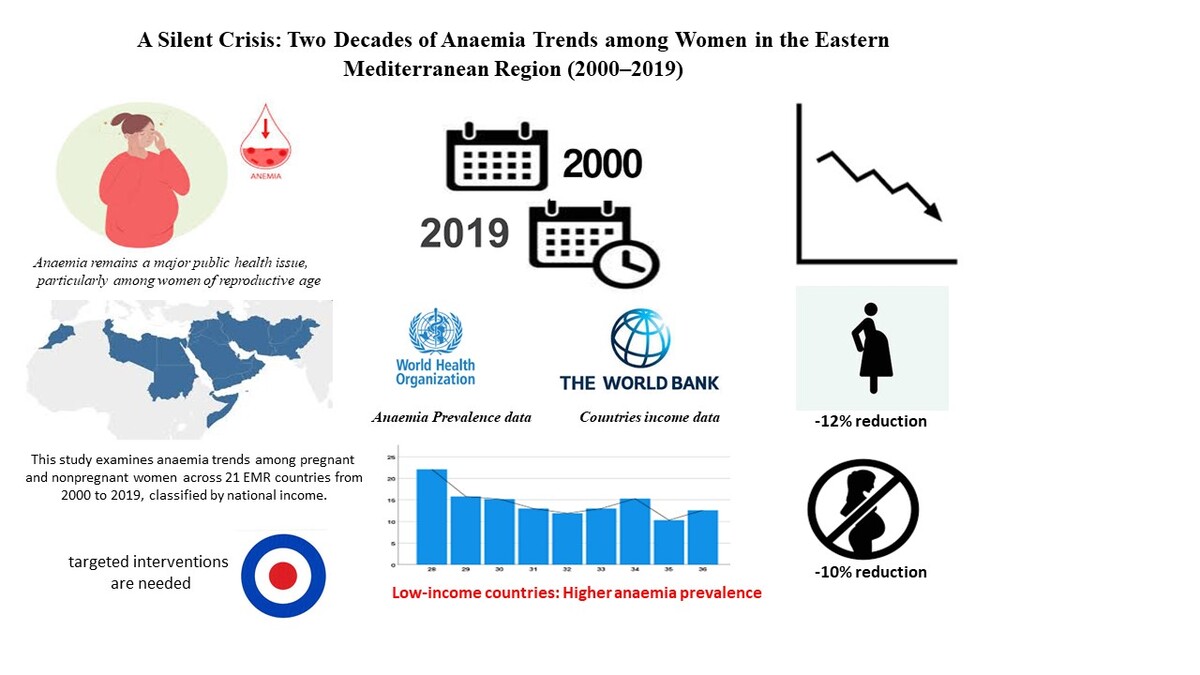Current issue
Archive
Manuscripts accepted
About the Journal
Editorial office
Editorial board
Section Editors
Abstracting and indexing
Subscription
Contact
Ethical standards and procedures
Most read articles
Instructions for authors
Article Processing Charge (APC)
Regulations of paying article processing charge (APC)
HEMATOLOGY / RESEARCH PAPER
A Silent Crisis: Two Decades of Anaemia Trends among Women in the Eastern Mediterranean Region (2000–2019)
1
Department of Medical Laboratory Science, College of Applied Medical Science, University of Ha’il, Saudi Arabia
2
Department of Medical Laboratory Science, College of Applied Medical Science, University of Hail, Hail 8227, Saudi Arabia, Saudi Arabia
3
Department of Mathematics, College of Science, University of Ha’il, Ha’il 55481, Saudi Arabia, Saudi Arabia
4
1 Department of Medical Laboratory Science, College of Applied Medical Science, University of Hail, Hail 8227, Saudi Arabia, Saudi Arabia
Submission date: 2025-02-10
Final revision date: 2025-03-14
Acceptance date: 2025-04-13
Online publication date: 2025-04-20
Corresponding author
Reem Eltayeb
Department of Medical Laboratory Science, College of Applied Medical Science, University of Ha’il, Ha’il 8227, Saudi Arabia
Department of Medical Laboratory Science, College of Applied Medical Science, University of Ha’il, Ha’il 8227, Saudi Arabia
KEYWORDS
TOPICS
ABSTRACT
Introduction:
Anaemia remains a major public health issue. This condition adversely impacts women of reproductive age, especially in low-income countries. Although there is an ongoing global effort to reduce anaemia prevalence, progress is slow and uneven. Anaemia exhibits unique patterns in the Eastern Mediterranean Region (EMR) due to this region’s economic disparities and variations in access to health services. This study examined trends in anaemia prevalence among pregnant and nonpregnant women in the EMR by national income.
Material and methods:
This retrospective cross-sectional study examined anaemia prevalence among pregnant and nonpregnant women in 21 EMR countries from 2000–2019 at five-year intervals. The data on anaemia prevalence were compiled by the World Health Organization (WHO), while the World Bank provided the income classifications. Descriptive statistics were used to examine trends in prevalence and their associations with each country’s income.
Results:
Although a general decrease in anaemia prevalence was observed among both pregnant and nonpregnant women, this improvement varied by income group. Pregnant women exhibited a greater reduction than nonpregnant women (-12% vs -10%). Low-income countries reported higher prevalences. The study revealed significant negative associations between national income and anaemia prevalence (p ˂ 0.001). While some countries demonstrated improvements, others exhibited unique or unexpected behaviours or stagnant rates.
Conclusions:
Economic differences significantly impact trends in anaemia prevalence among women of reproductive age in the EMR. Urgent, country-targeted interventions, particularly in low-income countries, are necessary to meet the WHO’s goal of reducing anaemia among women of reproductive age by 50% before 2030.
Anaemia remains a major public health issue. This condition adversely impacts women of reproductive age, especially in low-income countries. Although there is an ongoing global effort to reduce anaemia prevalence, progress is slow and uneven. Anaemia exhibits unique patterns in the Eastern Mediterranean Region (EMR) due to this region’s economic disparities and variations in access to health services. This study examined trends in anaemia prevalence among pregnant and nonpregnant women in the EMR by national income.
Material and methods:
This retrospective cross-sectional study examined anaemia prevalence among pregnant and nonpregnant women in 21 EMR countries from 2000–2019 at five-year intervals. The data on anaemia prevalence were compiled by the World Health Organization (WHO), while the World Bank provided the income classifications. Descriptive statistics were used to examine trends in prevalence and their associations with each country’s income.
Results:
Although a general decrease in anaemia prevalence was observed among both pregnant and nonpregnant women, this improvement varied by income group. Pregnant women exhibited a greater reduction than nonpregnant women (-12% vs -10%). Low-income countries reported higher prevalences. The study revealed significant negative associations between national income and anaemia prevalence (p ˂ 0.001). While some countries demonstrated improvements, others exhibited unique or unexpected behaviours or stagnant rates.
Conclusions:
Economic differences significantly impact trends in anaemia prevalence among women of reproductive age in the EMR. Urgent, country-targeted interventions, particularly in low-income countries, are necessary to meet the WHO’s goal of reducing anaemia among women of reproductive age by 50% before 2030.
Share
RELATED ARTICLE
We process personal data collected when visiting the website. The function of obtaining information about users and their behavior is carried out by voluntarily entered information in forms and saving cookies in end devices. Data, including cookies, are used to provide services, improve the user experience and to analyze the traffic in accordance with the Privacy policy. Data are also collected and processed by Google Analytics tool (more).
You can change cookies settings in your browser. Restricted use of cookies in the browser configuration may affect some functionalities of the website.
You can change cookies settings in your browser. Restricted use of cookies in the browser configuration may affect some functionalities of the website.



